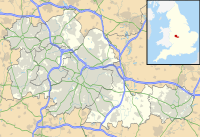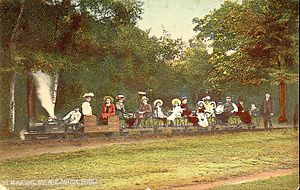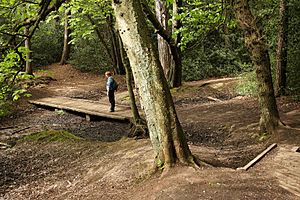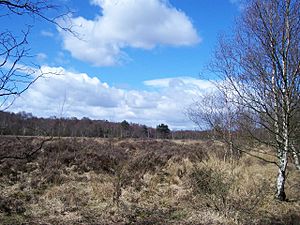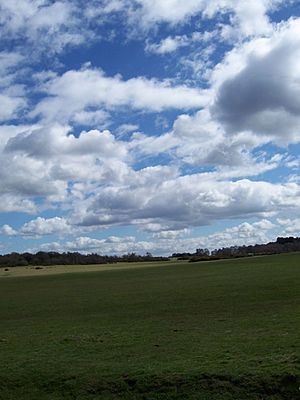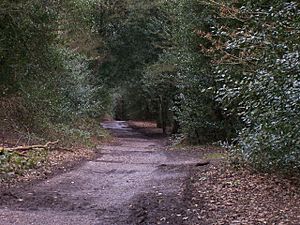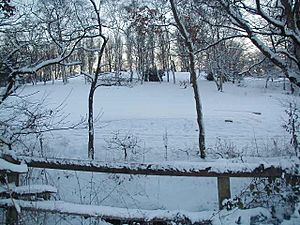Sutton Park, West Midlands facts for kids
Quick facts for kids Sutton Park |
|
|---|---|
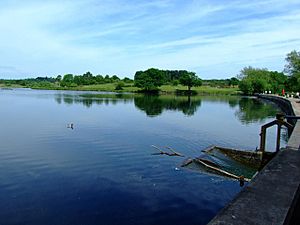
Longmoor Pool
|
|
| Location | Birmingham, England |
| Area | 971.25 hectares (2,400.0 acres) |
| Operated by | Birmingham City Council |
Sutton Park is a very large park located in Sutton Coldfield, Birmingham, West Midlands, England. It's one of the biggest urban parks in the United Kingdom.
Most of Sutton Park is a special protected area called a National Nature Reserve. Many parts are also a Scheduled Ancient Monument, which means they are important historical sites.
The park covers about 971 hectares (or 2,400 acres). It has a mix of different natural areas like heathland (open land with small shrubs), wetlands (marshy areas), and seven lakes. You'll also find large ancient woodlands, which cover about a quarter of the park.
Sutton Park offers many things to do! There are restaurants, two golf courses, a donkey sanctuary, and playgrounds for kids. You can enjoy activities like dog walking, pony trekking, bike riding, and flying kites. There are even special areas for flying model airplanes and helicopters. A railway line also runs through the park.
There's no fee to enter the park, but you might pay for parking on weekends during summer.
Contents
Park History: A Journey Through Time
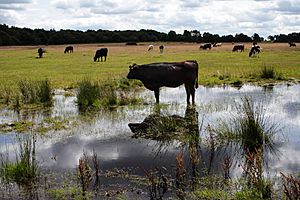
Sutton Park has a long and interesting history. During World War II, people digging for peat found flint arrowheads, showing that people lived here a very long time ago.
You can still see parts of an old Roman road called Icknield Street in the park. This road is noticeably raised and enters the park near the Royal Oak Gate. It leads towards a place called Streetly, which means "meadow by the paved street." You can still walk along this ancient road today! In 1909, two Roman coins were found in the park, showing Roman presence.
The Queen's Coppice, a group of trees planted in 1953, is where an ancient burial mound once stood. In 1808, people dug up a stone 'coffin' from this spot. Near Blackroot Pool, there are old earthworks from an ancient camp. No one knows for sure who built it – it might have been a hunting lodge used by Romans, Mercians, or Normans over time.
Royal Hunting Ground
Sutton Park was first set up as a Royal Forest by the Anglo-Saxon kings of Mercia around the 9th century. By the early 12th century, it became a medieval deer park for the Norman kings.
In 1528, King Henry VIII gave the land to the people of Sutton Coldfield. This happened because Bishop John Vesey, a friend of the King, asked for it as a gift for the town. The burning of charcoal that happened in the park is believed to have given Sutton Coldfield the "Coldfield" part of its name.
Park Lakes and Their Stories
Wyndley Pool is the oldest lake in the park, possibly from the 12th century or even earlier. The house of the Royal Steward, an important official, used to sit on a hill overlooking Wyndley Pool.
Keeper's Pool and Bracebridge Pool were created in the 15th century. Later, Powell's Pool, Longmoor Pool, and Blackroot Pool were made in the 18th century. These newer pools were built to power watermills. There was another pool at Boldmere, but it's now outside the park and has disappeared. Most of the park has remained untouched since then.
The Park's Railway Line
A railway line was built through the park in 1879. The park even had its own train station! The railway brought many more visitors to Sutton Park. The park's station closed in 1964, and now the line is only used for goods trains.
Miniature Railway Fun
A fun Sutton Miniature Railway ran near the Wyndley Leisure Centre from about 1905 until the 1960s. It was later taken apart, and its trains and engine shed are now at the Cleethorpes Coast Light Railway.
Wartime Camps in the Park
During World War I, camps were built in the park for soldiers recovering from injuries. In World War II, more camps were built. These camps were used for different groups of people, including U.S. forces before D-Day, and later for prisoners of war.
Scouting Jamboree
In 1957, Sutton Park hosted a huge international event: the 9th World Scout Jamboree. This celebrated 50 years of Scouting and brought together Scouts from all over the world. A small stone pillar in the middle of the park remembers this special event.
Radio 1 Roadshow
On August 30, 1992, about 100,000 fans came to Sutton Park for the biggest ever Radio 1 Roadshow. This event celebrated Radio 1's 25th anniversary and featured live music from popular bands.
Keepers Pool Lido
There was once a unique outdoor swimming pool, called a lido, at Keepers Pool. It was built in 1887. Sadly, the lido closed in 2003 after a fire and was completely burned down in 2004. The area where the lido was has now returned to being natural woodland and wetland.
Sports and Activities in Sutton Park
Sutton Park is a popular place for many sports. You can enjoy mountain biking, especially on "Skeleton Hill" for downhill riders. Sailing and canoeing happen mainly on Powell's Pool. The Royal Sutton Coldfield Canoe Club also uses Blackroot Pool for kayaking and canoeing.
Runners and walkers love the park's many paths and trails. Several running events take place here throughout the year, including:
- Seven Pools Run (March)
- Great Midlands Fun Run (June)
- Race for Life (June)
- City of Birmingham 10k / 5k Fun Run (September)
There's also a free 5 km parkrun event every Saturday morning at 9:00 am, starting at Banners Gate.
The City of Birmingham triathlon event is held in July, with the swimming part taking place in Powell's Pool. Be Military Fit holds outdoor fitness classes near the Boldmere Gate.
The park has countless cycling routes for all skill levels. You can even find videos of different routes on YouTube. There's an 18-hole golf course near the Streetly Gate entrance.
A special grassy area is set aside for flying model airplanes and helicopters. This area is between Boldmere Gate and the Jamboree Stone. Sutton Park has also been used for motor rallying, like the Lombard RAC Rally in the 1970s and 1980s.
Many watersports are enjoyed in the park, including fishing, rowing, and sailing on Powell's Pool. The Sutton Sailing Club (SSC) sails regularly on Wednesday evenings and Sunday afternoons in summer, and Sunday mornings in winter. Bishop Vesey Grammar School also practices rowing on Powell's Pool.
Wildlife in Sutton Park
Sutton Park is home to various wildlife. In the past, nightjars (a type of bird) used to breed here, but the last recorded sighting was in 1957. Since then, they have only been seen twice. Both red grouse and black grouse birds were also found in the park until the late 1800s.
Sutton Park Today

In 1997, most of Sutton Park was named a National Nature Reserve by English Nature. It's also on English Heritage's list of important historic parks and gardens. In 2005, a 20-year plan called 'Keepers of Time' began. This plan aims to remove non-native plants from the ancient woodlands and bring back native trees like oak, ash, and beech.
Birmingham City Council currently manages the park. In 2004, it was decided that local councillors for Sutton Coldfield would have more control over the park's management.
The roads inside the park now have strict rules. Main roads that used to allow cars to drive straight through the park are now blocked by sturdy gates. These gates open and close with sunrise and sunset. This change has greatly reduced traffic using the park as a shortcut, making the air cleaner and the roads safer for walkers and cyclists. It also reduces noise pollution.
Speed limits for cars in the park have been lowered twice, first to 20 mph in the 1980s, and then to 5 mph in 2004. Many speed bumps have also been removed from areas that are now only for pedestrians.
A funfair for small children continues to operate near Powell's Pool. It has rides like a go-kart track and manually operated pirate ship swings.
The Sea Cadets have a training vessel called "the Concrete Corvette" at Boldmere Gate. The headquarters of the 1st Sutton Coldfield Sea Scouts are also there, and the 9th Sutton Coldfield Scouts are on the other side of the park.
More police officers are now present in the park, especially at the main Town Gate. This has helped reduce vandalism and fires, though some incidents still occur.
In 2007, the National Cycle Network received funding to build the Plants Brook route. This will create a free off-road bicycle path from east Erdington to Sutton Park.
In 2012, a health advisory was issued due to a temporary health concern. This led to the cancellation of some running events that autumn.
During the COVID-19 pandemic, outdoor exercise became very important. Sutton Park remained busy even when other facilities were closed, as people used it for physical activity.


